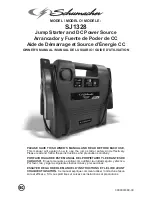
•
5
•
protective clothing. Avoid touching your
eyes while working near the battery.
2.11
If battery acid contacts your skin or
clothing, immediately wash the area
with soap and water. If acid enters your
eye, immediately flood the eye with cold
running water for at least 10 minutes and
get medical attention right away.
2.12
If battery acid is accidentally swallowed,
drink milk, the whites of eggs or water.
DO NOT induce vomiting. Seek medical
attention immediately.
WARNING! RISK OF CONTACT WITH
BATTERY ACID. BATTERY ACID IS A
HIGHLY CORROSIVE SULFURIC ACID.
2.13
Clean the battery terminals before using
the jump starter. During cleaning, keep
airborne corrosion from coming into
contact with your eyes, nose and mouth.
Use baking soda and water to neutralize
the battery acid and help eliminate
airborne corrosion. Do not touch your
eyes, nose or mouth.
2.14
Add distilled water to each cell until the
battery acid reaches the level specified
by the battery manufacturer. Do not
overfill. For a battery without removable
cell caps, such as valve regulated lead
acid batteries (VRLA), carefully follow the
manufacturer’s instructions.
2.15
Read, understand and follow all
instructions for the jump starter, battery,
vehicle and any equipment used near the
battery and jump starter.
2.16
Determine the voltage of the battery by
referring to the vehicle owner’s manual
and make sure that the output voltage of
the jump starter is correct.
2.17
Make sure that the jump starter cable
clips make tight connections.
2.18 WARNING:
This product contains one
or more chemicals known to the State
of California to cause cancer and birth
defects or other reproductive harm.
3. CONNECTING THE JUMP STARTER
WARNING! A SPARK NEAR THE
BATTERY MAY CAUSE A BATTERY
EXPLOSION. TO REDUCE THE RISK
OF A SPARK NEAR THE BATTERY:
3.1
Attach the output cables to the battery
and chassis as indicated below. Never
allow the output clips to touch each other.
3.2
Position the DC cables to reduce the risk of
damage by the hood, door and moving or
hot engine parts.
NOTE:
If it is necessary
to close the hood during the jump starting
process, ensure that the hood does not
touch the metal part of the battery clips or
cut the insulation of the cables.
3.3
Stay clear of fan blades, belts, pulleys
and other parts that can cause injury.
3.4
Check the polarity of the battery posts.
The POSITIVE (POS, P, +) battery post
usually has a larger diameter than the
NEGATIVE (NEG, N, -) post.
3.5
Determine which post of the battery is
grounded (connected) to the chassis.
If the negative post is grounded to the
chassis (as in most vehicles), see step
3.6. If the positive post is grounded to the
chassis, see step 3.7.
3.6
For a negative-grounded vehicle, connect
the POSITIVE (RED) clip from the jump
starter to the POSITIVE (POS, P, +)
ungrounded post of the battery. Connect
the NEGATIVE (BLACK) clip to the
vehicle chassis or engine block away from
the battery. Do not connect the clip to the
carburetor, fuel lines or sheet-metal body
parts. Connect to a heavy gauge metal
part of the frame or engine block.
3.7
For a positive-grounded vehicle, connect
the NEGATIVE (BLACK) clip from the
jump starter to the NEGATIVE (NEG, N, -)
ungrounded post of the battery. Connect
the POSITIVE (RED) clip to the vehicle
chassis or engine block away from the
battery. Do not connect the clip to the
carburetor, fuel lines or sheet-metal body
parts. Connect to a heavy gauge metal
part of the frame or engine block.
3.8
When disconnecting the jump starter, turn
all switches to off (if applicable), remove
the clip from the vehicle chassis, then
remove the clip from the battery terminal.






































